Home Blog Education Presentation Skills 101: A Guide to Presentation Success

Presentation Skills 101: A Guide to Presentation Success
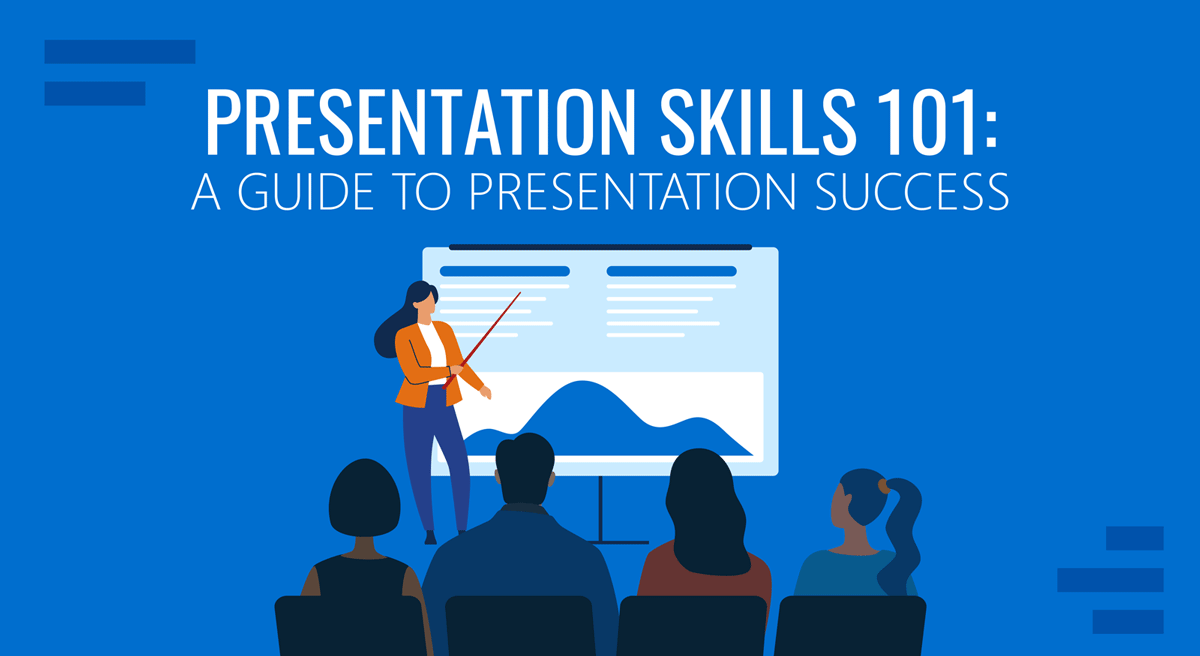
Getting the perfect presentation design is just a step toward a successful presentation. For the experienced user, building presentation skills is the answer to elevating the power of your message and showing expertise on any subject. Still, one can ask: is it the same set of skills, or are they dependable on the type of presentation?
In this article, we will introduce the different types of presentations accompanied by the skillset required to master them. The purpose, as always, is to retain the audience’s interest for a long-lasting and convincing message.
Table of Contents
The Importance of Presentation Skills
Persuasive presentations, instructional presentations, informative presentations, inspirational presentations, basic presentation skills, presentation techniques, what are the main difficulties when giving a presentation, recommendations to improve your presentation skills, closing statement.
Effective communication is the answer to reaching business and academic goals. The scenarios in which we can be required to deliver a presentation are as diverse as one can imagine. Still, some core concepts apply to all presentations.
We define presentation skills as a compendium of soft skills that directly affect your presentation performance and contribute to creating a great presentation. These are not qualities acquired by birth but skills you ought to train and master to delve into professional environments.
You may ask: is it really that evident when a presenter is not prepared? Here are some common signs people can experience during presentations:
- Evasive body language: Not making eye contact with the audience, arms closed tightly to the body, hands in pockets all the time.
- Lack of interest in the presenter’s voice: dull tone, not putting an effort to articulate the topics.
- Doubting when asked to answer a question
- Irksome mood
The list can go on about common presenter mistakes , and most certainly, it will affect the performance of any presented data if the lack of interest by the presenter is blatantly obvious. Another element to consider is anxiety, and according to research by the National Institute of Mental Health, 73% of the population in the USA is affected by glossophobia , which is the fear of public speaking, judgment, or negative evaluation by other people.
Therefore, presentation skills training is essential for any business professional who wants to achieve effective communication . It will remove the anxiety from presentation performance and help users effectively deliver their message and connect with the audience.
Archetypes of presentations
Persuasive presentations aim to convince the audience – often in short periods – to acquire a product or service, adhere to a cause, or invest in a company. For business entrepreneurs or politicians, persuasive presentations are their tool for the trade.
Unless you aim to be perceived as an imposter, a proper persuasive presentation has the elements of facts, empathy, and logic, balanced under a well-crafted narrative. The central pillar of these presentations is to identify the single factor that gathered your audience: it could be a market need, a social cause, or a revolutionary concept for today’s society. It has to be something with enough power to gather critiques – both good and bad.
That single factor has to be backed up by facts. Research that builds your hypothesis on how to solve that problem. A deep understanding of the target audience’s needs , concerns, and social position regarding the solution your means can offer. When those elements are in place, building a pitch becomes an easy task.
Graphics can help you introduce information in a compelling format, lowering the need for lengthy presentations. Good presentation skills for persuasive presentations go by the hand of filtering relevant data and creating the visual cues that resonate with what your audience demands.
One powerful example of a persuasive presentation is the technique known as the elevator pitch . You must introduce your idea or product convincingly to the audience in a timeframe between 30 seconds and less than 2 minutes. You have to expose:
- What do you do
- What’s the problem to solve
- Why is your solution different from others
- Why should the audience care about your expertise
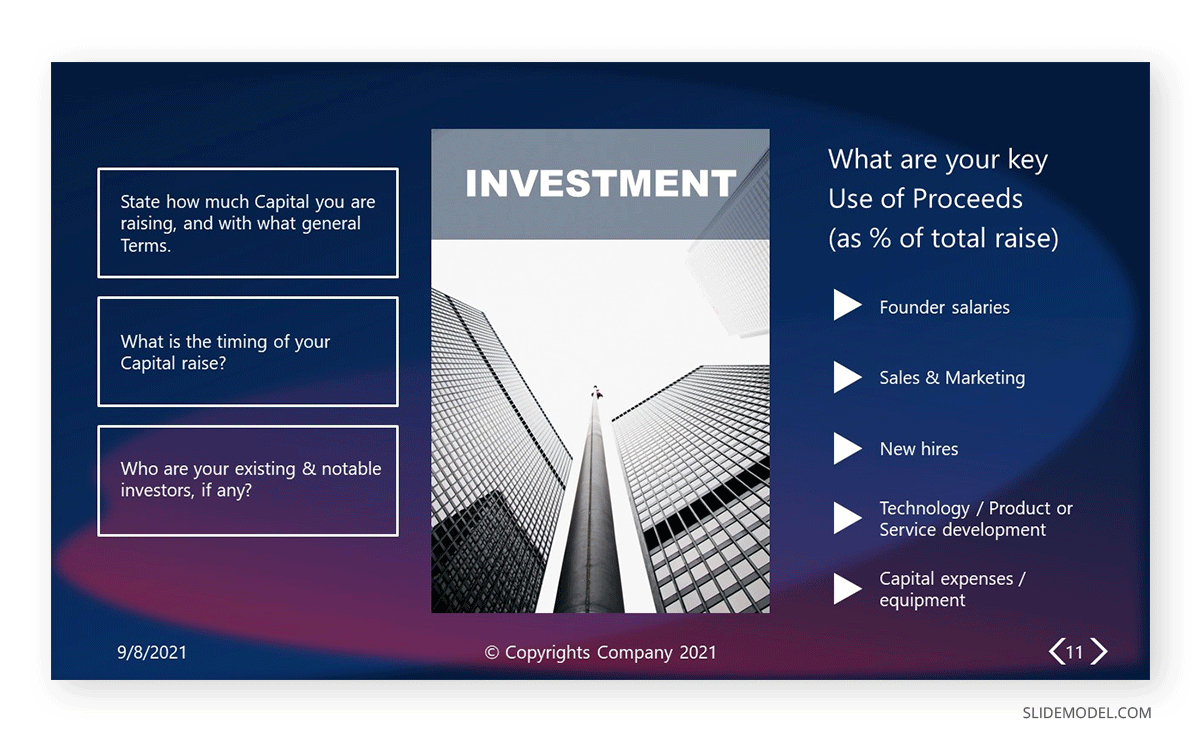
For that very purpose, using engaging graphics with contrasting colors elevates the potential power of your message. It speaks professionalism, care for details, and out-of-the-box thinking. Knowing how to end a presentation is also critical, as your CTAs should be placed with care.
Therefore, let’s resume the requirements of persuasive presentations in terms of good presentation skills:
- Identifying problems and needs
- Elaborating “the hook” (the element that grabs the audience’s attention)
- Knowing how to “tie” your audience (introducing a piece of information related to the hook that causes an emotional impact)
- Broad knowledge of body language and hand gestures to quickly convey your message
- Being prepared to argue a defense of your point of view
- Handling rejection
- Having a proactive attitude to convert opportunities into new projects
- Using humor, surprise, or personal anecdotes as elements to sympathize with the audience
- Having confidence
- Be able to summarize facts and information in visually appealing ways
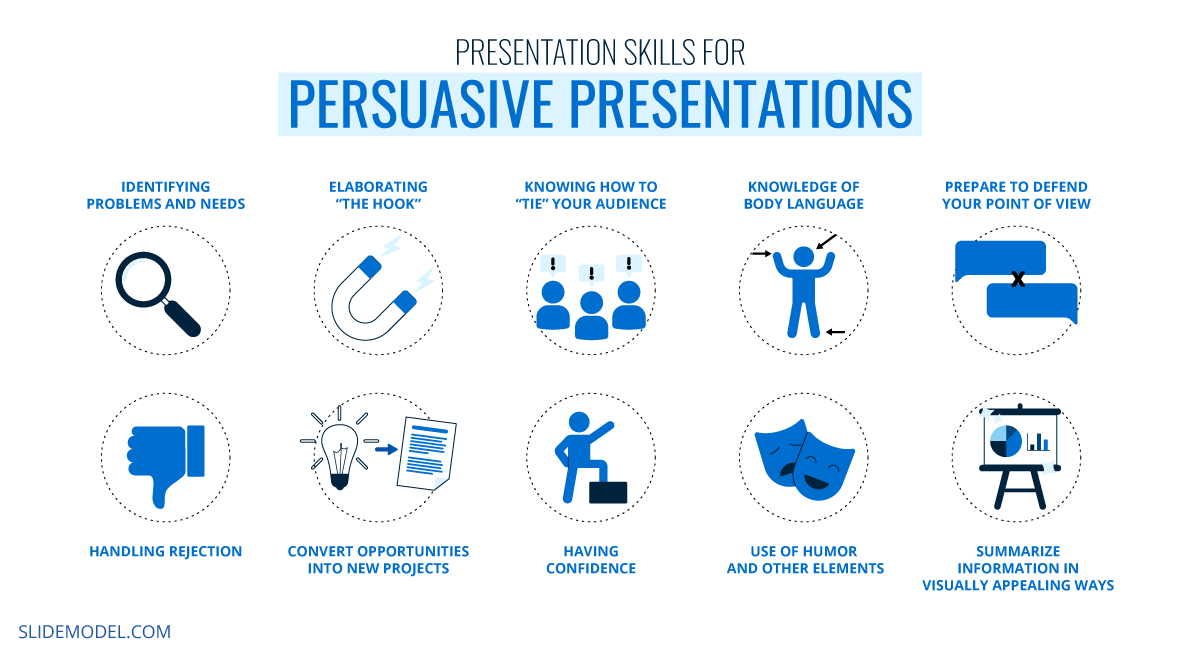
You can learn more about persuasive presentation techniques by clicking here .
In the case of instructional presentations, we ought to differentiate two distinctive types:
- Lecture Presentations : Presentations being held at universities or any other educative institution. Those presentations cover, topic by topic, and the contents of a syllabus and are created by the team of teachers in charge of the course.
- Training Presentations : These presentations take place during in-company training sessions and usually comprise a good amount of content that is resumed into easy-to-take solutions. They are aimed to coach employees over certain topics relevant to their work performance. The 70-20-10 Model is frequently used to address these training situations.
Lecture presentations appeal to the gradual introduction of complex concepts , following a structure set in the course’s syllabus. These presentations often have a similar aesthetic as a group of professors or researchers created to share their knowledge about a topic. Personal experience does tell that course presentations often rely on factual data, adequately documented, and on the theoretical side.
An example of a presentation that lies under this concept is a Syllabus Presentation, used by the teaching team to introduce the subject to new students, evaluation methods, concepts to be learned, and expectations to pass the course.
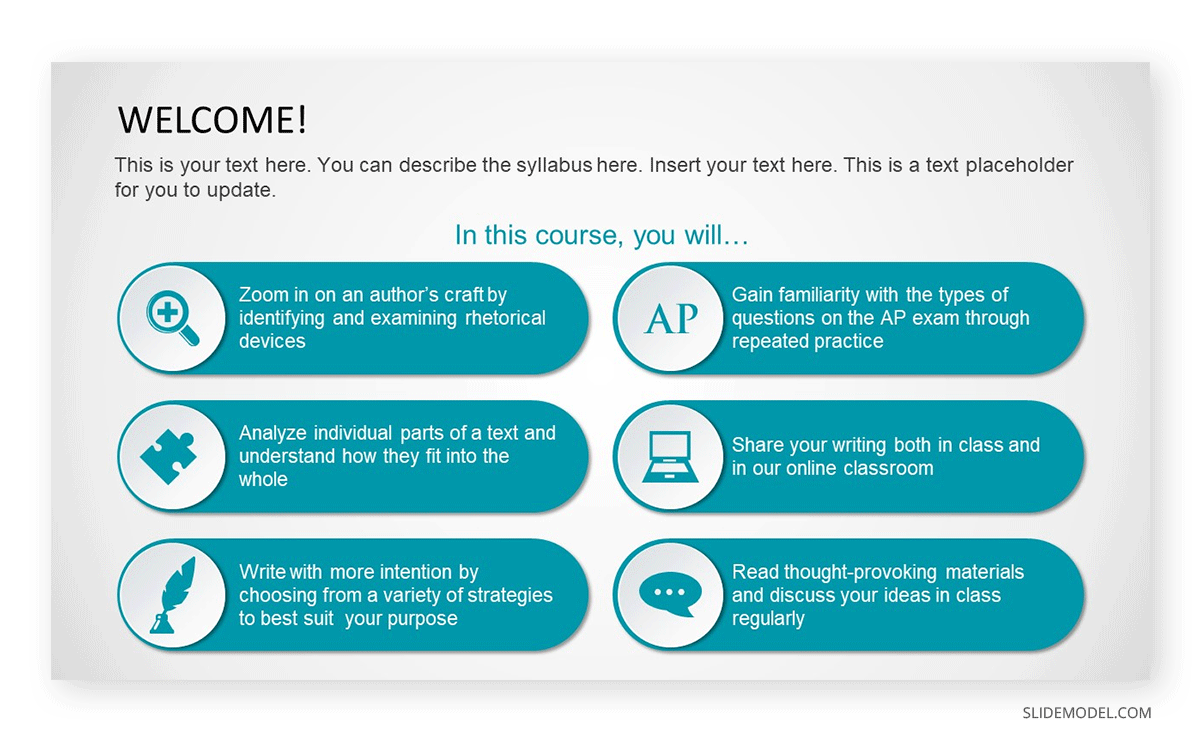
On the other hand, training presentations are slide decks designed to meet an organization’s specific needs in the formal education of their personnel. Commonly known as “continuous education,” plenty of companies invest resources in coaching their employees to achieve higher performance results. These presentations have the trademark of being concise since their idea is to introduce the concepts that shall be applied in practice sessions.
Ideally, the training presentations are introduced with little text and easy-to-recognize visual cues. Since the idea is to summarize as much as possible, these are visually appealing for the audience. They must be dynamic enough to allow the presenter to convey the message.
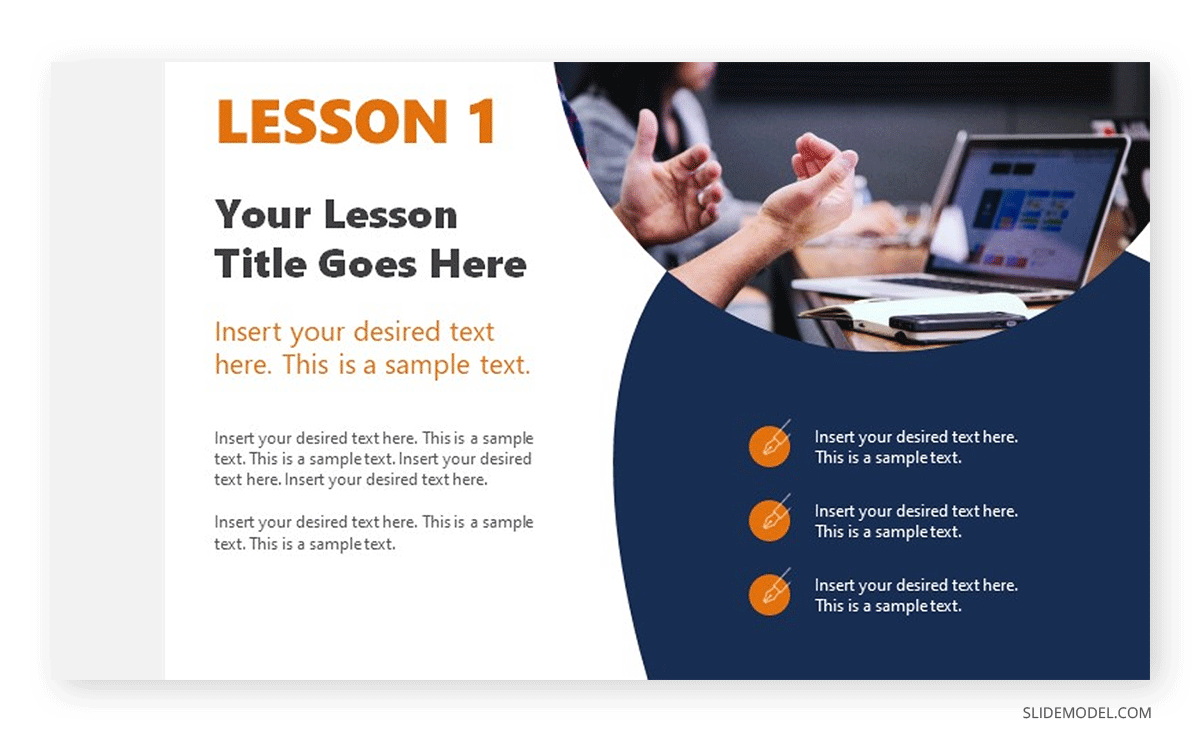
Those key takeaways remind employees when they revisit their learning resources and allow them to ruminate on questions that fellow workers raise.
To sum up this point, building presentation skills for instructional presentations requires:
- Ability to put complex concepts into simpler words
- Patience and a constant learning mindset
- Voice training to deliver lengthy speeches without being too dense
- Ability to summarize points and note the key takeaways
- Empathizing with the audience to understand their challenges in the learning process
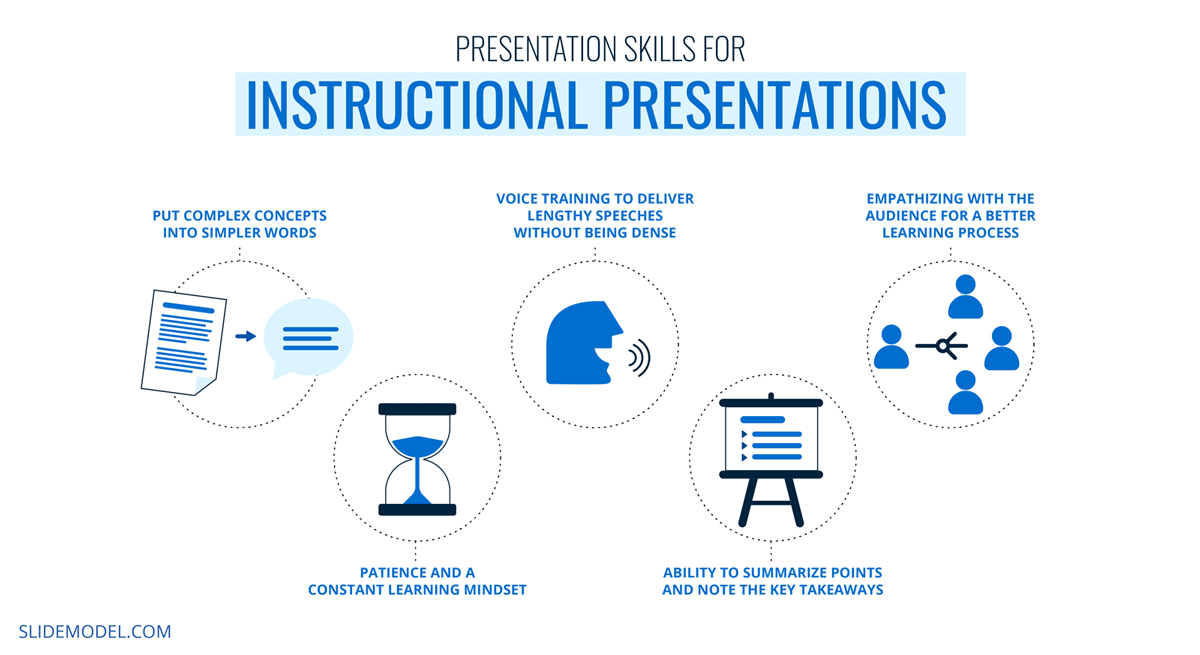
The informative presentations take place in business situations, such as when to present project reports from different departments to the management. Another potential usage of these presentations is in SCRUM or other Agile methodologies, when a sprint is completed, to discuss the advance of the project with the Product Owner.
As they are presentations heavily dependent on data insights, it’s common to see the usage of infographics and charts to express usually dense data in simpler terms and easy to remember.
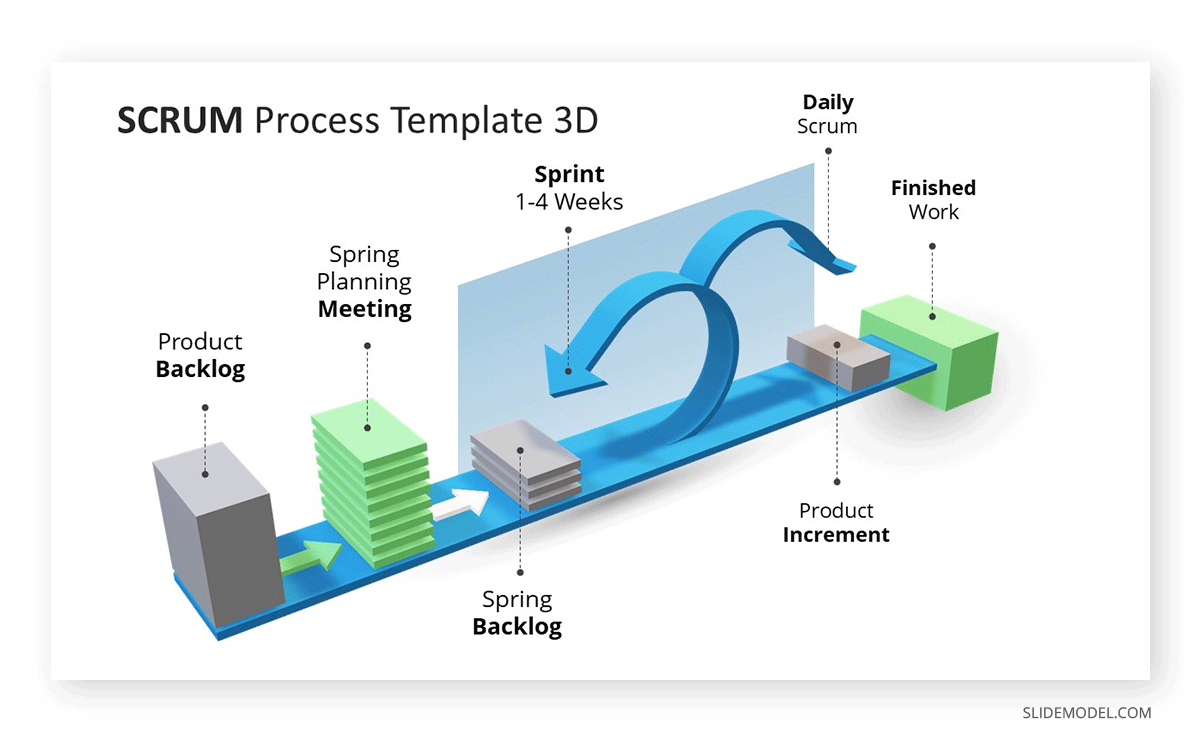
Informative presentations don’t just fall into the business category. Ph.D. Dissertation and Thesis presentations are topics that belong to the informative presentations category as they condense countless research hours into manageable reports for the academic jury.
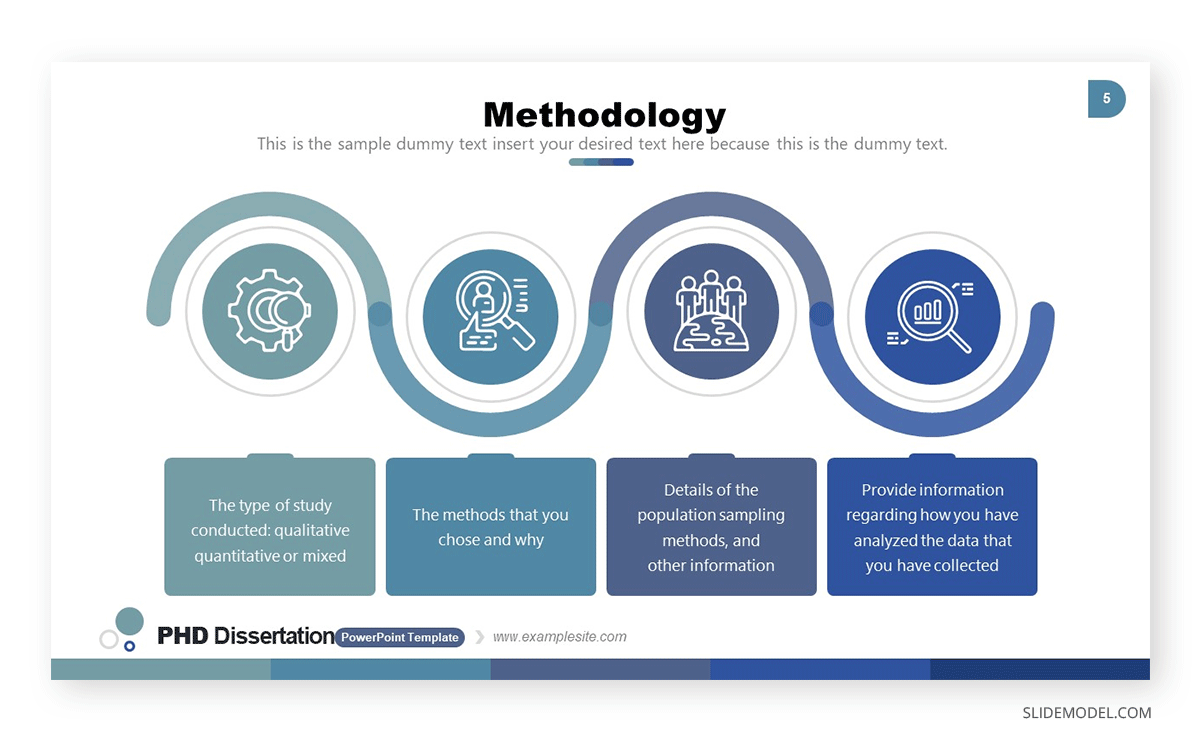
Since these informational presentations can be perceived as lengthy and data-filled, it is important to learn the following professional presentation skills:
- Attention to detail
- Be able to explain complex information in simpler terms
- Creative thinking
- Powerful diction
- Working on pauses and transitions
- Pacing the presentation, so not too much information is divulged per slide
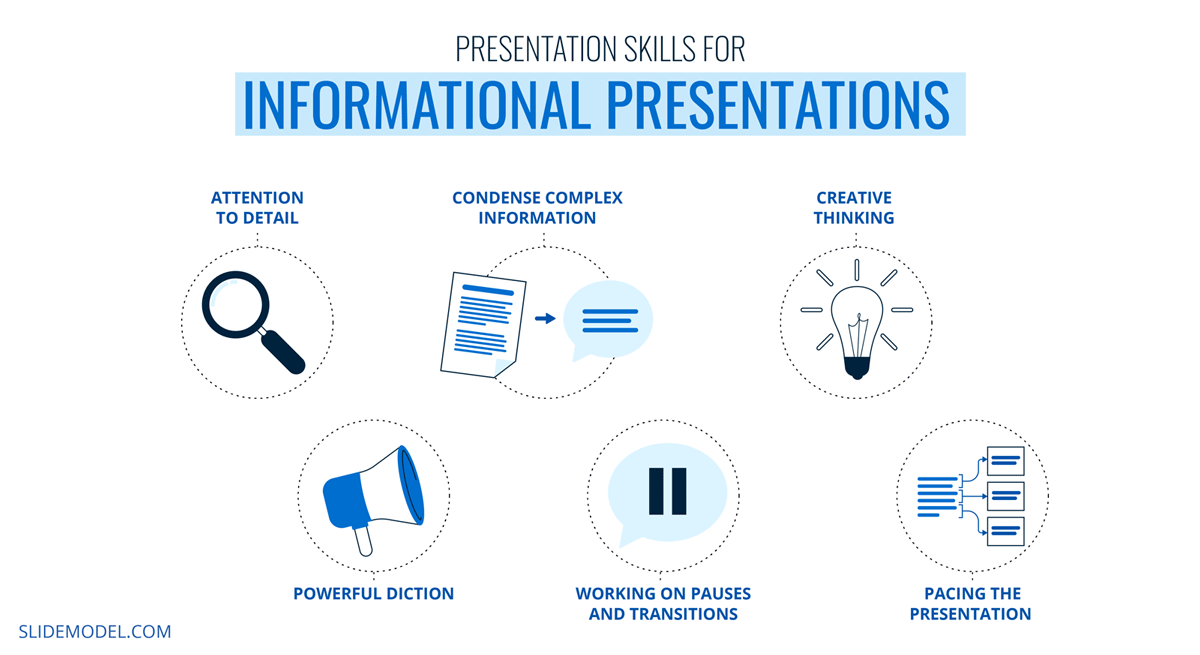
The leading inspirational platform, TEDx, comes to mind when talking about inspirational presentations. This presentation format has the peculiarity of maximizing the engagement with the audience to divulge a message, and due to that, it has specific requirements any presenter must meet.
This presentation format usually involves a speaker on a stage, either sitting or better standing, in which the presenter engages with the audience with a storytelling format about a life experience, a job done that provided a remarkable improvement for society, etc.

Empathizing with the audience is the key ingredient for these inspirational presentations. Still, creativity is what shapes the outcome of your performance as people are constantly looking for different experiences – not the same recipe rephrased with personal touches. The human factor is what matters here, way above data and research. What has your experience to offer to others? How can it motivate another human being to pursue a similar path or discover their true calling?
To achieve success in terms of communication skills presentation, these inspirational presentations have the following requirements:
- Focus on the audience (engage, consider their interests, and make them a part of your story)
- Putting ego aside
- Creative communication skills
- Storytelling skills
- Body language knowledge to apply the correct gestures to accompany your story
- Voice training
- Using powerful words
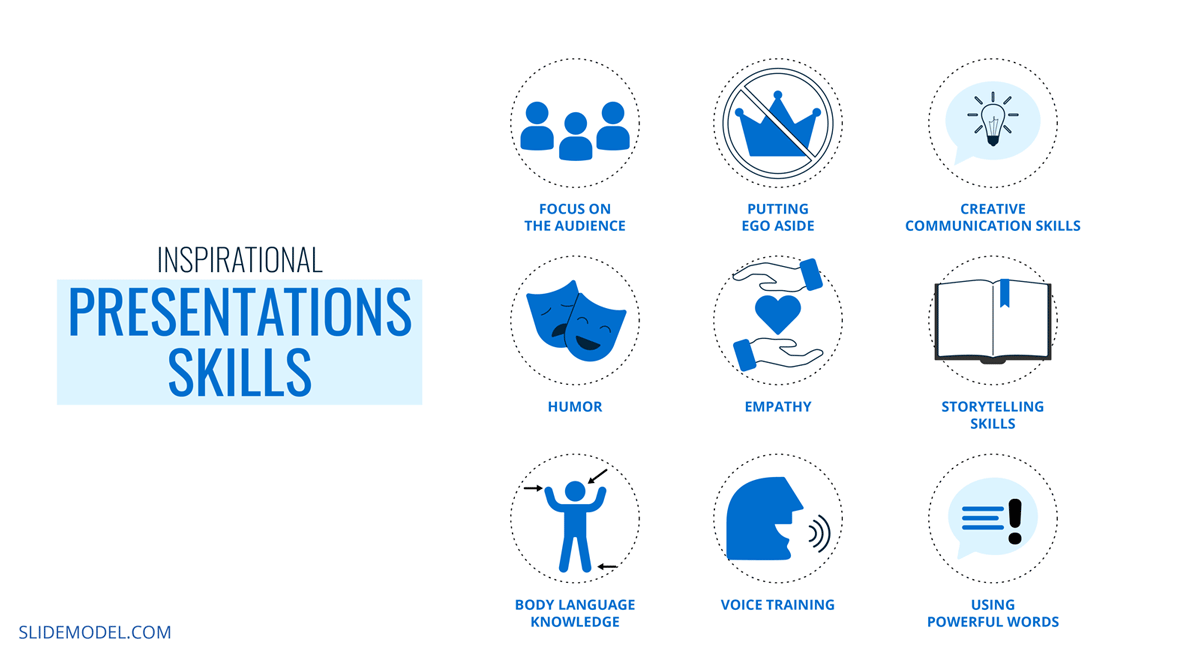
After discussing the different kinds of presentations we can come across at any stage of our lives, a group of presentation skills is standard in any type of presentation. See below what makes a good presentation and which skills you must count on to succeed as a presenter.
Punctuality
Punctuality is a crucial aspect of giving an effective presentation. Nothing says more about respect for your audience and the organization you represent than delivering the presentation on time . Arriving last minute puts pressure on the tech team behind audiovisuals, as they don’t have enough preparation to test microphones, stage lights, and projector settings, which can lead to a less powerful presentation Even when discussing presentations hosted in small rooms for a reduced audience, testing the equipment becomes essential for an effective presentation.
A solution for this is to arrive at least 30 minutes early. Ideally, one hour is a sweet spot since the AV crew has time to check the gear and requirements for your presentation. Another benefit of this, for example, in inspirational presentations, is measuring the previous presenter’s impact on the audience. This gives insights about how to resonate with the public, and their interest, and how to accommodate your presentation for maximum impact.
Body Language
Our bodies can make emotions transparent for others, even when we are unaware of such a fact. Proper training for body language skills reduces performance anxiety, giving the audience a sense of expertise about the presented topic.
Give your presentation and the audience the respect they deserve by watching over these potential mistakes:
- Turning your back to the audience for extended periods : It’s okay to do so when introducing an important piece of information or explaining a graph, but it is considered rude to give your back to the audience constantly.
- Fidgeting : We are all nervous in the presence of strangers, even more, if we are the center of attention for that moment. Instead of playing with your hair or making weird hand gestures, take a deep breath to center yourself before the presentation and remember that everything you could do to prepare is already done. Trust your instincts and give your best.
- Intense eye contact : Have you watched a video where the presenter stared at the camera the entire time? That’s the feeling you transmit to spectators through intense eye contact. It’s a practice often used by politicians to persuade.
- Swearing : This is a no-brainer. Even when you see influencers swearing on camera or in podcasts or live presentations, it is considered an informal and lousy practice for business and academic situations. If you have a habit to break when it comes to this point, find the humor in these situations and replace your swear words with funny alternatives (if the presentation allows for it).
Voice Tone plays a crucial role in delivering effective presentations and knowing how to give a good presentation. Your voice is a powerful tool for exposing your ideas and feelings . Your voice can articulate the message you are telling, briefing the audience if you feel excited about what you are sharing or, in contrast, if you feel the presentation is a burden you ought to complete.
Remember, passion is a primary ingredient in convincing people. Therefore, transmitting such passion with a vibrant voice may help gather potential business partners’ interest.
But what if you feel sick prior to the presentation? If, by chance, your throat is sore minutes before setting foot on the stage, try this: when introducing yourself, mention that you are feeling a bit under the weather. This resonates with the audience to pay more attention to your efforts. In case you don’t feel comfortable about that, ask the organizers for a cup of tea, as it will settle your throat and relax your nerves.
Tech Skills
Believe it or not, people still feel challenged by technology these days. Maybe that’s the reason why presentation giants like Tony Robbins opt not to use PowerPoint presentations . The reality is that there are plenty of elements involved in a presentation that can go wrong from the tech side:
- A PDF not opening
- Saving your presentation in a too-recent PowerPoint version
- A computer not booting up
- Mac laptops and their never-ending compatibility nightmare
- Not knowing how to change between slides
- Not knowing how to use a laser pointer
- Internet not working
- Audio not working
We can come up with a pretty long list of potential tech pitfalls, and yet more than half of them fall in presenters not being knowledgeable about technology.
If computers aren’t your thing, let the organization know about this beforehand. There is always a crew member available to help presenters switch between slides or configure the presentation for streaming. This takes the pressure off your shoulders, allowing you to concentrate on the content to present. Remember, even Bill Gates can get a BSOD during a presentation .
In this section, we will list some of the most useful presentation skills presenters should hone. Remember, none of these techniques are expected to come naturally; they result from effort and practice.
Be passionate
Passion engages audiences, making your message resonate. Presenting with genuine enthusiasm elevates your energy and improves delivery, capturing attention and inspiring trust – an effect commonly seen in inspirational presentations. To convey passion, know the subject well enough to feel confident and excited to share insights.
Expressing strong belief in your message encourages listeners to feel the same. Avoid overacting—natural enthusiasm goes further than forced energy. To hone this, practice until you’re comfortable with the material and can easily express why it matters. A passionate approach is contagious; if you’re invested in the subject, the audience will likely stay engaged and leave a lasting impression.
Be yourself
Authenticity is critical for making a genuine connection with your audience. Being yourself while presenting builds credibility and helps you appear approachable and trustworthy. Staying true to yourself reduces nerves and makes you more engaging since audiences appreciate sincerity over a rehearsed facade.
Focus on what you naturally bring rather than trying to imitate another speaker’s style. This could be a sense of humor, calm, collected presence, or relatable anecdotes. To achieve this, practice speaking in a conversational tone and avoid rehearsing too rigidly; you want to sound prepared yet spontaneous.
Greet the audience
Starting with a warm greeting sets the tone for a welcoming and engaging presentation. A simple “Hello” or “Good morning” is often enough, but make it authentic and with a smile. Introducing yourself and perhaps adding a light remark about the setting or a shared experience builds rapport.
Acknowledge the audience for taking the time to be there, which shows respect and creates a positive connection. This initial interaction establishes your presence as friendly and prepared, making people more receptive to your message. It also lets you settle into your environment, easing initial nervousness.
Ask rhetorical questions
Rhetorical questions engage your audience by prompting them to think without expecting verbal responses. This technique draws listeners into your narrative, creating mental engagement as they consider the answers privately.
Use rhetorical questions strategically to highlight important points or to introduce a topic. Questions like, “Have you ever wondered…?” or “What would you do if…?” encourage reflection and make your points more relatable. Avoid overusing them, as it can disrupt the flow. Instead, use them as subtle engagement tools to keep your audience thinking and invested in the subject.
Backup plan
A backup plan prevents unexpected disruptions from derailing your presentation. Technology issues, unforeseen delays, or lost materials can occur, so preparing alternatives is essential. Bring printed slides, a PDF of your presentation, and any necessary files on a flash drive.
Familiarize yourself with alternate ways to deliver your content, such as verbal summaries if visual aids fail. Practicing flexibility also enhances your confidence since you’re prepared for the unexpected. A solid backup plan keeps you calm and professional, ensuring small setbacks don’t compromise the presentation’s quality.
Adding humor to your presentation lightens the atmosphere and keeps the audience engaged. A well-placed joke or light-hearted comment can make you appear approachable and relatable when appropriate.
To use humor effectively, understand your audience’s comfort level with different styles of humor and avoid jokes that might be inappropriate. Focus on subtle, universal humor that aligns with the presentation theme, like a playful observation or funny anecdote. Overuse can detract from your message, so keep it balanced. Humor should support the presentation’s flow, not become the main focus.
Data can make your points credible and concrete, showing that your claims are backed by evidence. However, presenting data effectively means more than just listing numbers. Use visuals like charts or graphs to simplify complex information, allowing the audience to grasp the core message quickly.
Avoid overwhelming them with too much data; focus on the most relevant figures that support your argument. Introduce the data in context, explaining why it’s significant, and always keep your core message in mind. Well-presented data can strengthen your case, while too much can distract you.
Interactivity
Interactive elements increase engagement by actively involving the audience. Asking for a show of hands, incorporating small group discussions, or even live polling makes the experience dynamic and personalized. Interactive presentations help break up one-way communication’s monotony and keep listeners attentive.
Plan interactivity at key points in your presentation to reinforce essential concepts or check understanding. Compelling interactivity adapts to the size and type of audience—keep it simple with larger groups. Inviting participation creates a more memorable experience and enhances the audience’s connection with your message.
Presentations, while valuable for conveying information and ideas, can be daunting for many individuals. Here are some common difficulties people encounter when giving presentations:
Public Speaking Anxiety
Glossophobia, the fear of public speaking, affects a significant portion of the population. This anxiety can lead to nervousness, trembling, and forgetfulness during a presentation.
Lack of Confidence
Many presenters struggle with self-doubt, fearing that they may not be knowledgeable or skilled enough to engage their audience effectively.
Content Organization
Organizing information in a coherent and engaging manner can be challenging. Presenters often grapple with how to structure their content to make it easily digestible for the audience. Artificial Intelligence can help us significantly reduce the content arrangement time when you work with tools like our AI Presentation Maker (made for presenters by experts in presentation design).
Audience Engagement
Keeping the audience’s attention and interest throughout the presentation can be difficult. Distractions, disengaged attendees, or lack of interaction can pose challenges.
Technical Issues
Technology glitches, such as malfunctioning equipment, incompatible file formats, or poor internet connectivity, can disrupt presentations and increase stress.
Time Management
Striking the right balance between providing enough information and staying within time limits is a common challenge. Going over or under the allotted time can affect the effectiveness of the presentation.
Handling Questions and Challenges
Responding to unexpected questions, criticism, or challenges from the audience can be difficult, especially when presenters are unprepared or lack confidence in their subject matter.
Visual Aids and Technology
Creating and effectively using visual aids like slides or multimedia can be a struggle for some presenters. Technical competence is essential in this aspect.
Language and Articulation
Poor language skills or unclear articulation can hinder effective communication. Presenters may worry about stumbling over words or failing to convey their message clearly.
Maintaining appropriate and confident body language can be challenging. Avoiding nervous habits, maintaining eye contact, and using gestures effectively requires practice.
Overcoming Impersonal Delivery
In virtual presentations, maintaining a personal connection with the audience can be difficult. The absence of face-to-face interaction can make it challenging to engage and read the audience.
Cultural and Diversity Awareness
Presenting to diverse audiences requires sensitivity to cultural differences and varying levels of familiarity with the topic.
In this section, we gathered some tips on how to improve presentation skills that can certainly make an impact if applied to your presentation skills. We believe these skills can be cultivated to transform into habits for your work routine.
Tip #1: Build a narrative
One memorable way to guarantee presentation success is by writing a story of all the points you desire to cover. This statement is based on the logic behind storytelling and its power to connect with people .
Don’t waste time memorizing slides or reading your presentation to the audience. It feels unnatural, and any question that diverts from the topic in discussion certainly puts you in jeopardy or, worse, exposes you as a fraud in the eyes of the audience. And before you ask, it is really evident when a presenter has a memorized speech.
Build and rehearse the presentation as if telling a story to a group of interested people. Lower the language barrier by avoiding complex terms that maybe even you aren’t fully aware of their meaning. Consider the ramifications of that story, what it could lead to, and which are the opportunities to explore. Then, visualize yourself giving the presentation in a natural way.
Applying this technique makes the presentation feel like second nature to you. It broadens the spectrum in which you can show expertise over a topic or even build the basis for new interesting points of view about the project.
Tip #2: Don’t talk for more than 3 minutes per slide
It is a common practice of presenters to bombard the audience with facts and information whilst retaining the same slide on the screen. Why can this happen? It could be because the presenter condensed the talk into very few slides and preferred to talk. The reality is that your spectators won’t retain the information you are giving unless you give visual cues to help that process.
Opt to prepare more slides and pace your speech to match the topics shown on each slide. Don’t spend more than 3 minutes per slide unless you have to introduce a complex piece of data. Use visual cues to direct the spectators about what you talk about, and summarize the principal concepts discussed at the end of each section.
Tip #3: Practice meditation daily
Anxiety is the number one enemy of professional presenters. It slowly builds without you being aware of your doubts and can hinder your performance in multiple ways: making you feel paralyzed, fidgeting, making you forget language skills or concepts, affecting your health, etc.
Meditation is an ancient practice taken from Buddhist teachings that train your mind to be here in the present. We often see the concepts of meditation and mindfulness as synonyms, whereas you should be aware that meditation is a practice that sets the blocks to reach a state of mindfulness. For presenters, being in the here and now is essential to retain focus, but meditation techniques also teach us to control our breathing and be in touch with our body signals when stress builds up.
The customary practice of meditation has an impact on imagination and creativity but also helps to build patience – a skill much needed for connecting with your audience in instructional presentations.
Having the proper set of presentation skills can be quite subjective. It goes beyond presentation tips and deepens into how flexible we can be in our ability to communicate ideas.
Different presentations and different audiences shape the outcome of our efforts. Therefore, having a basic understanding of how to connect, raise awareness, and empathize with people can be key ingredients for your career as a presenter. A word of advice: success doesn’t happen overnight. It takes dedication and patience to build communication skills . Don’t condition your work to believe you will be ready “someday”; it’s best to practice and experience failure as part of the learning process.
Like this article? Please share
Business Presentations, Presentation Approaches, Presentation Skills Filed under Education
Related Articles

Filed under Business • December 18th, 2024
Deloitte Presentation Structure: Best Practices for Consultants
Learn the key elements of Deloitte presentation structure, tips for impactful delivery, and how to craft client-focused consulting presentations.
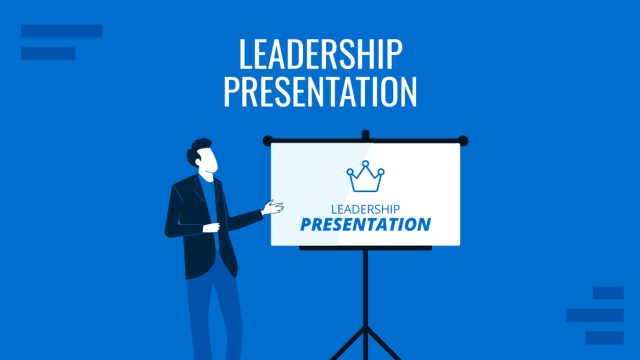
Filed under Business • December 11th, 2024
Mastering Leadership Presentations: Guide + Examples
Learn how to craft impactful leadership presentations, with examples, PPT templates, and strategies to inspire, guide, and influence your audience.

Filed under Presentation Ideas • November 28th, 2024
The Power of Audience Engagement: Strategies and Examples
As presenters, captivating the interest of our viewers is the most important thing. Join us to learn all that’s required to boost audience engagement.
Leave a Reply
Effective Presentation skills

This document provides guidance on how to develop and deliver effective presentations. It discusses the importance of planning, preparing, practicing, and presenting. Some key steps outlined include determining your audience and goals, creating a clear structure with an introduction, content, and conclusion, using prompts, visual aids, and rehearsing to manage time and delivery. Effective presentation skills such as making eye contact, speaking clearly, engaging the audience, and answering questions are also covered. The document emphasizes being well-prepared, practicing, having confidence in your topic, and avoiding stress to deliver successful presentations. Read less


More Related Content
- 1. Effective Presentation skills PRESENTED BY MR.AMIT H.KANSE. (M. PHARM ) RAJGAD DNYANPEETH COLLEGE OF PHARMACY BHOR,PUNE. QUALITY ASSURANCE TECHNIQUES 2017-2018
- 2. Everyone Want to BE Best Speaker
- 3. What is your Dream Trainer Style Teacher Style VS
- 4. Definition Presentation is a means of communication which can be adapted to various speaking situations, such as talking to a group, addressing a meeting or briefing a team.
- 5. Presentation skills Following are the steps include in preparing effective presentation: 1. Plan 2. Prepare 3. Practice 4. Present
- 6. Planning
- 7. Planning Planning usually include following questions: 1. Who is your audience? 2. Why are they here? 3. What is your goal? 4. How long will it be? 5. Where will it take place?
- 8. Prepare – Following points must keep in mind while 1. preparing 2. Structure 3. Prompt 4. Visual aids 5. Voice 6. Appearance 7. Style 8. Questions
- 9. Structure – Write your presentation in this order: A. Objective B. Beginning or introduction C. Main content D. Summary, conclusion and recommendations E. Questions
- 10. Prompt ( cause or bring about ) 1. Short bullet points, key words only. 2. Put your entire prompt onto your power point slides. 3. These prompt are for you.
- 11. Visual aids 1. Use simple fonts, colors and graphs. 2. Use images and clipart. 3. 3 to 7 bullets per slide. 4. Don’t over crowd your slides, it will not look professional. 5. New or different visual aids wake people up.
- 12. Voice 1. Louder and clear than your normal pitch. 2. Vary pitch and volume. 3. Over emphasis. (stress given to a word or words when speaking to indicate particular importance.)
- 13. Professional dress code
- 14. Style 1. You already have a style. don’t try to copy others. 2. Use words and sentences which you use in normal days. 3. Be yourself.
- 15. Questions Sketch an idea that what kind of questions audience may ask.
- 17. Preparation material You can use following items to make the content of your presentation: 1. Handouts (leaflet, pamphlet, brochure, bulletin) 2. Personal notes 3. Internet 4. Visual aids. (film , slide or model)
- 18. Practice 1. Rehearse all points what you prepare. 2. Rehearse with all visual aids and handouts. 3. Practice again and again to manage time. 4. Rehearse in front of mirror or a friend.
- 19. Present 1. Make a strong start. 2. Engage the audience in first 2-3 minutes. 3. Show your passion through your movements and gestures. a movement of part of the body, especially a hand or the head, to express an idea or meaning. 1. Make an eye contact. 2. Don’t forget to smile as well.
- 20. Speaker’s impact
- 21. Flaws ( Defect )in presentation
- 22. Flaws in presentation 1. Lack of experience. 2. Lack of strong excitement 3. Lack of practice. 4. Lack of related material. 5. Lack of confidence. 6. Pausing , delay. 7. Unclear, indefinite in the results that you want to conclude.
- 23. Factors for successful presentation
- 24. 1. Be over prepared. 2. Rehearse and practice. 3. Grip on your topic. 4. Know your subject. 5. Be positive. 6. Avoid stress
- 25. Conclusion 1. Always prepare. 2. Channelize your fear. 3. Interact with your audience.

Improving PowerPoint Presentation Skills: Tips for PPT Presentation Skills
- Presentation Skills
- June 5, 2024

You’re sitting in a dimly lit conference room, eyes fixed on the screen as yet another PowerPoint presentation unfolds. Slide after slide, bullet points blur together, and your mind wanders. Sound familiar? We’ve all been there.
But what if a presentation didn’t have to be dull and uninspiring? What if they could captivate, inform, and leave a lasting impression?
In this comprehensive guide, we’ll explore the nitty-gritty of a PowerPoint presentation skills , uncovering tips for crafting engaging slideshows that command attention and resonate with your audience.
From mastering the basics of PowerPoint’s interface to fine-tuning your delivery techniques, we’ll cover everything you need to know in your presentation to elevate it to the next level.
To make your slideshows more impactful, we will delve into how to improve various elements in the presentation process, ensuring you create compelling content that stands out in the competitive landscape.
Whether you’re a seasoned presenter looking to refine your skills or a novice seeking guidance, this blog is your roadmap to success.
Join us as we explore the art and science of PowerPoint presentations, unlocking the tools and techniques that will empower you to communicate confidently and clearly.
So, let’s dive in and discover the tips to improve your PowerPoint presentation together.
Phase 1: Understanding The Basics
Laying a robust foundation is similar to building a sturdy structure in PowerPoint presentations—it’s essential for creating compelling slideshows. In this section, we’ll discuss the fundamental elements of PowerPoint, equipping you with the knowledge needed to navigate the software seamlessly and unleash your creativity.

Familiarisation With PowerPoint Interface
To begin your journey with PowerPoint, let’s first acquaint ourselves with its interface. Upon launching the application, you’ll encounter a familiar sight – a blank canvas awaiting your creativity. At the top, you’ll find the Ribbon, a dynamic toolbar housing various tabs and commands. These tabs, including Home, Insert, Design, Transitions, Animations, and the Slide Show, serve as gateways to PowerPoint’s vast array of features and tools. Take your time to explore each tab and familiarise yourself with its offerings, from basic formatting options to advanced functionalities.
Exploring Different Slide Layouts And Designs
Now that you’re comfortable with the interface let’s dive into the realm of slide layouts and designs. Gone are the days of mundane bullet-point slides – PowerPoint offers a treasure trove of pre-designed layouts and themes to elevate your presentations. From title slides to content slides to conclusion slides, each layout serves a unique purpose and sets the tone for your presentation. Experiment with different designs, colours, and fonts to find a style that resonates with your message and captivates your audience.
Utilising Basic Formatting Tools
With your layout chosen, it’s time to populate your slides with content. Text, images, and multimedia elements are the building blocks of your presentation, and mastering basic formatting tools is key to ensuring their effectiveness. Explore font options, sizes, and colours to enhance readability and visual appeal. Likewise, leverage formatting tools for objects such as shapes, icons, and SmartArt to convey complex ideas with clarity and precision. Remember, simplicity is key – aim for clean, concise slides that convey your message effectively.
Phase 2: Structuring Your Presentation
In crafting a compelling presentation, the structure serves as the backbone that supports your message and captivates your audience.
In this section, we’ll explore two distinct approaches to structuring your presentation: leveraging pyramid principle to create impact and influence, and employing Monroe’s Motivated Sequence to tell a story and instil urgency.
Creating Impact And Influence with Pyramid Principle
The Pyramid Principle, developed by Barbara Minto, is a structured approach to presenting ideas logically, clearly, and compellingly. It involves organising your thoughts in a hierarchical structure, starting with the main idea and breaking it down into supporting arguments and evidence. This approach helps ensure that your message is coherent and impactful, making it easier for your audience to follow and understand.
1. Start with the main idea (Top of the Pyramid)
Begin your presentation with the key message or main idea you want to convey. This is the most important point you want your audience to take away. State it clearly and succinctly to grab their attention from the outset.
2. Provide Supporting Arguments (Middle of the Pyramid)
After stating your main idea, present the key arguments that support it. These arguments should be logically connected to your main idea and provide a strong rationale for why it is valid. Each supporting argument should be a separate point that contributes to the overall message.
3. Present Evidence and Examples (Base of the Pyramid)
To reinforce your supporting arguments, provide concrete evidence and real-world examples. This can include data, case studies, testimonials, or any other form of proof that lends credibility to your claims. The evidence should be relevant and compelling, helping to convince your audience of the validity of your main idea.
Telling A Story And Creating Urgency With Monroe’s Motivated Sequence
In this section, we’ll explore how to structure your presentation using Monroe’s Motivated Sequence to tell a compelling story and instil urgency in your audience.

Capture your audience’s attention right from the start by highlighting a shocking statistic, asking a thought-provoking question, or sharing a captivating anecdote related to the challenges your organisation currently faces. Possible Elements to Include:
Start with a surprising fact or statistic
Ask a thought-provoking question
Use a story or share personal experiences
Incorporate humour or suspense
Utilise visual aids or a prop
Engage the audience with participation
By grabbing their attention with a compelling hook, you set the stage for the rest of your presentation and ensure that your audience is fully engaged from the outset.
Next, establish the need for change by outlining the specific pain points and challenges your organisation faces with its current project management system. Paint a vivid picture of the consequences of inaction and the missed opportunities for improvement. Possible elements to include:
Identify the problem
Establish the significance
Use examples and anecdotes
Provide a solution
Establish credibility
Appeal to emotion
By highlighting the urgent need for improvement, you create a sense of dissatisfaction with the status quo and lay the groundwork for your proposed solution.
Satisfaction:
Present your proposed solution – the implementation of a new project management system – as the answer to your organisation’s problems. Clearly articulate the benefits and advantages of adopting the new system, addressing the specific needs and concerns of your audience. Possible elements to include:
Clearly articulate the solution
Address potential concerns
Provide multiple solutions
Provide evidence
Show how to implement the solution
Use clear and concise language
By showcasing the benefits of your solution, you inspire hope and enthusiasm among your audience, motivating them to embrace change.
Visualisation:
Help your audience envision the positive outcomes and benefits of adopting your proposed solution by painting a vivid picture of the future state. Describe the transformative impact the new project management system will have on their daily work lives and the organisation as a whole. Possible elements to include:
Use graphics and images
Use storytelling
Use metaphors and analogies
Use real-world examples
Use interactive elements
By inspiring your audience to visualise the possibilities, you ignite their imagination and fuel their desire for change.
Conclude your presentation with a clear call to action that prompts your audience to take the next steps toward implementing the new project management system. Provide specific instructions and resources to facilitate their involvement and commitment to the initiative. Possible elements to include:
Provide a clear call-to-action
Use persuasive language
Use social proof
Provide clear instructions
Create a sense of urgency
Break it down into smaller steps
By issuing a compelling call to action, you galvanise your audience into action and create a sense of urgency around the need for change.
Phase 3: Designing Engaging Slides
From choosing the right colour scheme and fonts to incorporating multimedia elements, we’ll explore the essential components of slide design that will elevate your presentation to the next level.

Right Colour Scheme And Fonts
Colour and typography play a crucial role in conveying your message and evoking the desired emotional response from your audience. When selecting a colour scheme for your slides, opt for colours that complement your brand identity or the theme of your presentation.
Consider using contrasting colours for text and background to ensure readability, and avoid overwhelming your audience with too many vibrant hues.
Similarly, choose fonts that are easy to read and visually appealing. Stick to one or two primary fonts throughout your presentation to maintain consistency and coherence. Sans-serif fonts like Arial or Calibri are often preferred for on-screen readability, while serif fonts like Times New Roman or Georgia can lend a touch of elegance to your slides.
High-Quality Images And Graphics
Visual imagery can be enhanced with the impact of your message and make your presentation more memorable. Instead of relying solely on text, incorporate high-quality images and graphics that reinforce your key points and capture your audience’s attention.
Choose images that are relevant to your content and convey your message effectively, avoiding clichéd stock photos whenever possible.
Utilise graphics such as icons, illustrations, and charts to simplify complex concepts and add visual interest to your slides. Ensure that all images and graphics are of high resolution and properly aligned within your slides to maintain a polished and professional appearance.
Animations And Transitions
Animations and transitions can add a dynamic element to your presentation and help guide your audience’s focus from one point to the next. However, use them sparingly and purposefully to avoid distracting your audience or detracting from your message. Consider using subtle animations such as fade-ins or slide transitions to introduce new content or emphasise key points.
Be mindful of the timing and duration of animations, ensuring that they enhance rather than detract from the flow of your presentation.
Avoid excessive or gimmicky animations that may overshadow your content or come across as unprofessional.
Ensuring Consistency
Consistency is key to creating a cohesive and polished presentation that leaves a lasting impression on your audience. Maintain a consistent visual style, including colour scheme, fonts, and layout, across all slides to reinforce your branding and enhance readability.
Use slide templates or master slides to establish a uniform design framework for your presentation, ensuring that each slide adheres to the same design guidelines. Pay attention to details such as alignment, spacing, and formatting to create a visually harmonious presentation that reflects attention to detail and professionalism.
Phase 4: Enhancing Aesthetics and Interactivity
In this section, we’ll explore techniques for enhancing the aesthetics of your presentation and incorporating interactive elements to engage your audience effectively.

Utilising Bullet Points Effectively
Bullet points are a versatile tool for organising information and improving the readability of your slides. Follow these guidelines to use the bullet points effectively:

Keep it Concise: Use bullet points to convey key ideas or supporting details in a concise and digestible format. Limit each bullet point to one idea or concept to avoid overwhelming your audience with too much information.
Maintain Consistency: Use consistent formatting for bullet points throughout your presentation to create a sense of coherence and professionalism. Align bullet points consistently, and ensure that spacing and indentation are uniform across slides.
Prioritise Information: Arrange bullet points in order of importance or logical sequence to guide your audience’s attention and understanding. Use bullet points to highlight key takeaways or action items, ensuring that your message is clear and easy to follow.
Keeping Slides Clutter Free
Clean and clutter-free slides are essential for maintaining audience engagement and conveying your message effectively. Follow these principles to keep your slides clean and visually appealing:

Limit Text: Avoid overcrowding slides with excessive text or information. Keep text blocks concise and use visuals, such as images or icons, to complement and reinforce key points.
Embrace White Space: Use white space strategically to create a sense of balance and focus on your slides. Leave ample space between text, images, and other elements to improve readability and visual clarity.
Choose a Cohesive Design: Select a consistent design theme or template for your presentation to ensure visual cohesion. Use complementary colours, fonts, and layouts to create a professional and polished appearance.
Adding Interactive Elements
Interactive elements can enhance audience engagement and make your presentation more dynamic and memorable. Consider incorporating the following interactive features into your PowerPoint presentation:

Hyperlinks: Include hyperlinks to external websites, documents, or resources related to your presentation topic. Encourage audience members to explore additional information or resources at their own pace.
Clickable Buttons: Create clickable buttons or icons that trigger actions such as advancing to the next slide, revealing hidden content, or launching multimedia elements. Use buttons strategically to prompt audience interaction and guide the flow of your presentation.
Polls and Surveys: Integrate polls or surveys into your presentation to gather feedback, gauge audience opinions, or spark discussions. Use polling software or built-in PowerPoint features to create interactive polls that encourage audience participation.
Conclusion: P owerpoint Presentation Skills
Mastering PowerPoint presentation skills can transform mundane slideshows into captivating, impactful experiences that resonate with your audience.
By understanding the basics, structuring your content effectively using techniques, and enhancing your slides with engaging designs and interactive elements, you can elevate your presentations to new heights. Whether you’re persuading stakeholders, training a team, or delivering a keynote address, the ability to craft and deliver powerful presentations is an invaluable asset.
Embrace these strategies and tools to communicate with confidence, clarity, and creativity, leaving a lasting impression every time you present.

Rishabh Bhandari
Rishabh Bhandari is the Content Strategist at Kapable. Rishabh likes to transform complex ideas into captivating narratives relatable to the target audience. He loves telling stories through his content. He believes that stories have the power to shift mindsets and move mountains. He has 3 years of experience in educational blog writing and copywriting.
The Roles of Leadership in Strategy Implementation
Effective negotiation skills in communication, kapable updates.
Stay connected and get the latest updates by following us on our social media channels

Develop Must-Have Skills To Navigate Workplace Challenges And Build Executive Presence
Subscribe To Our Newsletter
Gain insider access to expert strategies and solutions for leadership success
Explore Topics
- Presentation Skills (21)
- Stage Fear (3)
- Conflict Management (17)
- Emotional Intelligence (44)
- Articulation (6)
- Delegation (5)
- Story Telling (9)
- Thinking Skills (2)
- Communication Skills (30)
- Public Speaking (12)
- Leadership (98)
- Persuasion (10)
- Self Confidence (17)
- Negotiation Skills (31)
Recent Posts

200 Public Speaking Topics: Unique Speech Ideas for Students in English
- 22 January 2024

Inspiring Leadership Stories: Short Narratives with Moral Lessons
- 15 January 2024

Self Confidence Swami Vivekananda Quotes: Wisdom and Inspiration
- 16 February 2024

Behavioral Theory of Leadership: Definition, Approach in Organisational Behavior
- 20 October 2023

What is Executive Leadership? – Definition, Meaning, Examples, Strategies & Style
- 19 January 2024
Begin your transformational journey
You can also check out.

Emotional Intelligence & Entrepreneurship

Leading Through Crisis: Strategies For Effective Crisis Management

Comprehensive Emotional Intelligence Questionnaire: Self-Evaluation, Scoring, and Daniel Goleman’s Assessment
Frequently asked questions.
We train working professionals on enhancing the essential skills so that they become better thinkers, communicators, and leaders. Our comprehensive programs cover key aspects of leadership including strategic thinking, effective communication, and management capabilities.
Our programs are ideal for anyone looking to enhance their executive presence, lead teams effectively, and communicate with confidence and charisma to make a significant impact in their organisation.
- Your Journey

IMAGES
COMMENTS
Apr 14, 2014 · Presentation Skills is one of the most important skills for impressing others. There are three key steps involved in making an effective presentation: 1. Planning 2. Preparation 3. Delivery All these can be successfully done through proper preparation and practice. Even the best public speakers adopt these vital steps. Read less
Jan 7, 2014 · Effective Presentation skills 2. Definition • A presentation is a means of communication which can be adapted to various speaking situations, such as talking to a group, addressing a meeting or briefing a team.
Oct 21, 2024 · Recommendations to improve your presentation skills. In this section, we gathered some tips on how to improve presentation skills that can certainly make an impact if applied to your presentation skills. We believe these skills can be cultivated to transform into habits for your work routine. Tip #1: Build a narrative
Dec 9, 2017 · Effective presentation skills such as making eye contact, speaking clearly, engaging the audience, and answering questions are also covered. The document emphasizes being well-prepared, practicing, having confidence in your topic, and avoiding stress to deliver successful presentations. Read less
Sep 17, 2024 · Using presentation skills for PPT helps form an association between your message and branding. There’s no better way to do that than with your brand colors. PowerPoint makes it easy to change color themes, adding your brand colors and logo to each slide.
Jun 5, 2024 · Mastering PowerPoint presentation skills can transform mundane slideshows into captivating, impactful experiences that resonate with your audience. By understanding the basics, structuring your content effectively using techniques, and enhancing your slides with engaging designs and interactive elements, you can elevate your presentations to ...